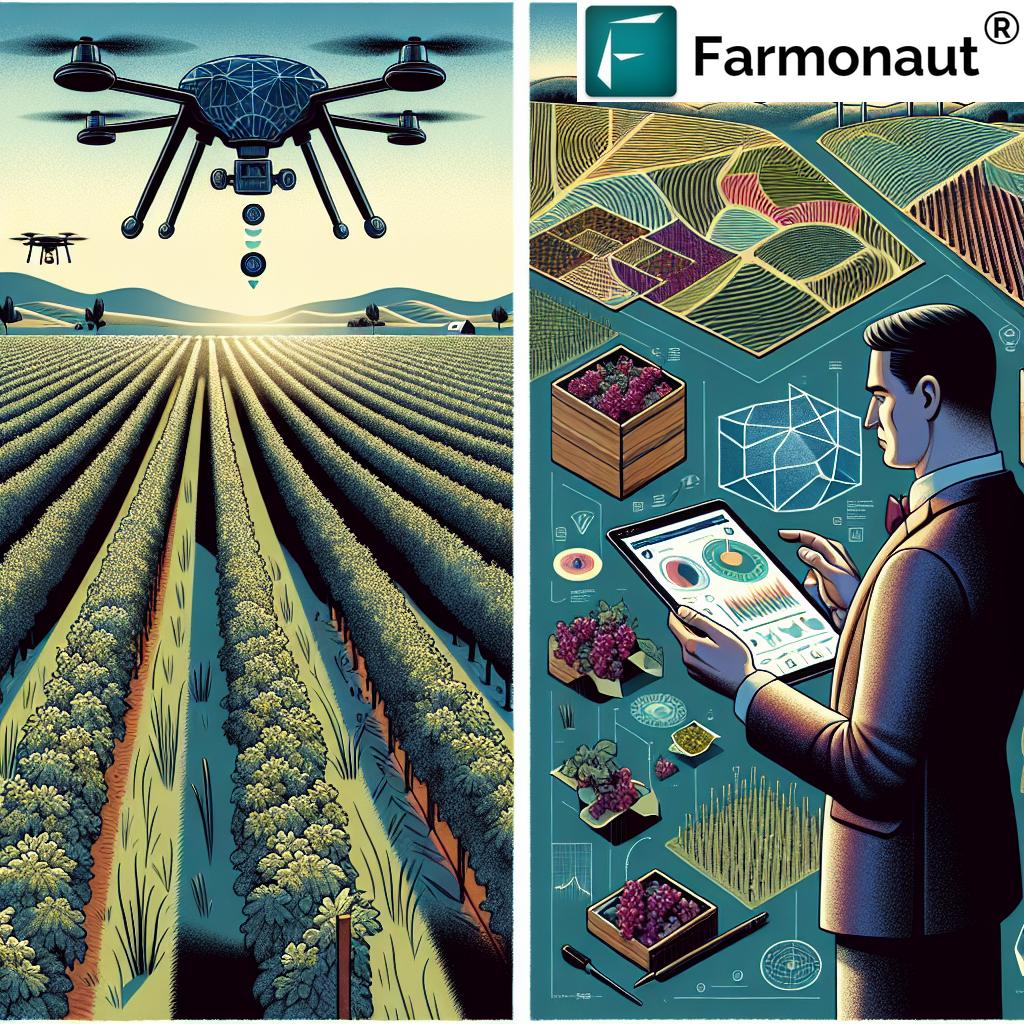Revolutionizing Australian Wine Exports: How AgTech Solutions Are Transforming Sustainable Viticulture and Market Growth
“Australian wine exports have grown by 30% in the last decade due to sustainable viticulture practices and AgTech solutions.”
In the ever-evolving landscape of global agriculture, the Australian wine industry stands as a shining example of innovation and adaptability. As we delve into the world of Australian wine exports, we’ll explore how cutting-edge AgTech solutions and sustainable viticulture practices are reshaping the sector, driving market growth, and setting new standards for quality and efficiency in winemaking.
The Rise of Australian Wine on the Global Stage
Australian wine has long been celebrated for its unique character and exceptional quality. In recent years, we’ve witnessed a remarkable transformation in the industry, fueled by a perfect blend of traditional winemaking expertise and innovative agricultural technologies. This synergy has not only enhanced the quality of Australian wines but has also significantly boosted their presence in international markets.
The Australian wine sector has embraced digital agriculture tools and precision viticulture technology, revolutionizing every aspect of wine production – from grape growing to export logistics. These advancements have positioned Australian wines at the forefront of the global market, appealing to discerning consumers who value both quality and sustainability.
Sustainable Viticulture: The Cornerstone of Australian Wine Success
At the heart of Australia’s wine export success lies a commitment to sustainable viticulture. This approach encompasses a range of practices designed to minimize environmental impact while maximizing grape quality and yield. Let’s explore some key aspects of sustainable winegrowing that are setting Australian wines apart:
- Climate-Smart Winegrowing: Australian vintners are adapting to changing climate conditions by implementing innovative techniques such as canopy management and water-efficient irrigation systems.
- Organic Wine Production: There’s a growing trend towards organic winemaking, which eliminates the use of synthetic pesticides and fertilizers, appealing to health-conscious consumers worldwide.
- Grape Variety Management: Careful selection and management of grape varieties that are well-suited to Australia’s diverse climates ensure optimal quality and sustainability.
These sustainable practices not only contribute to the production of exceptional wines but also resonate with environmentally conscious consumers in key export markets such as the European Union, United States, and various Asian countries.

AgTech Solutions: Transforming Vineyard Management
The integration of advanced agricultural technologies has been a game-changer for Australian vineyards. These AgTech solutions are enhancing every aspect of vineyard management, from planting to harvest. Here’s how technology is revolutionizing the industry:
- Precision Viticulture Technology: GPS-guided tractors and drones equipped with multispectral cameras provide detailed insights into vine health and soil conditions.
- Digital Agriculture Tools: Sophisticated software platforms enable real-time monitoring of vineyard conditions, facilitating data-driven decision-making.
- GIS in Viticulture: Geographical Information Systems (GIS) are being used to map and analyze vineyard terroir, optimizing grape growing conditions.
One of the leading providers of these innovative solutions is Farmonaut, a company at the forefront of agricultural technology. Farmonaut offers advanced, satellite-based farm management solutions that are transforming the way vineyards operate.
Farmonaut: Revolutionizing Vineyard Management
Farmonaut’s cutting-edge technology is making a significant impact on Australian viticulture. Their satellite-based crop health monitoring system provides vintners with real-time insights into vegetation health, soil moisture levels, and other critical metrics. This data-driven approach allows for more precise irrigation, fertilizer usage, and pest management, ultimately leading to optimized crop yields and reduced resource wastage.
The Jeevn AI Advisory System, another innovative offering from Farmonaut, delivers personalized farm advisory services, including real-time insights, weather forecasts, and expert crop management strategies. By analyzing satellite data and other inputs, Jeevn AI generates customized advice that helps improve farm productivity and efficiency.
“GIS-enhanced vineyard management software has increased grape yield efficiency by up to 25% in Australian vineyards.”
Comparative Analysis of Vineyard Management Methods
| Management Aspect | Traditional Method | Farmonaut-Enhanced Method | Estimated Improvement |
|---|---|---|---|
| Irrigation | Scheduled watering based on general climate data | Precision irrigation using real-time soil moisture data | 30% reduction in water usage |
| Pest Control | Regular pesticide application | Early pest detection through satellite imaging | 25% decrease in pesticide use |
| Yield Prediction | Historical data and manual field sampling | AI-driven analysis of satellite imagery and field data | 20% increase in prediction accuracy |
| Fertilizer Application | Uniform application across vineyard | Targeted application based on soil and plant health data | 15% reduction in fertilizer use |
| Harvest Timing | Based on calendar and visual inspection | Optimized using multispectral imaging and weather forecasts | 10% improvement in grape quality |
This table clearly demonstrates the significant improvements that Farmonaut’s technology brings to vineyard management. By adopting these advanced methods, Australian wine producers are not only enhancing their efficiency but also contributing to more sustainable and environmentally friendly viticulture practices.
Navigating Wine Export Regulations and Markets
As Australian wine continues to gain popularity worldwide, understanding and navigating export regulations becomes crucial for success in the global market. Here’s an overview of key considerations for Australian wine exporters:
- Wine Export Regulations: Compliance with both Australian and international regulations is essential. This includes adhering to labelling requirements, product standards, and export documentation processes.
- Labelling Requirements: Different markets have specific labelling regulations. For instance, the European Union, United States, and Asian markets each have unique requirements for wine labels, including information on alcohol content, allergens, and geographical indications.
- Documentation Processes: Proper documentation is crucial for smooth export operations. This includes certificates of origin, phytosanitary certificates, and customs declarations.
To assist with these complex processes, many Australian wine exporters are turning to digital solutions that streamline documentation and ensure compliance with various international standards.
Key Export Markets for Australian Wine
Australian wine has found success in various international markets, each with its unique preferences and challenges. Let’s explore some of the primary export destinations:
- European Union: A sophisticated market with a strong appreciation for quality wines. Australian wines are gaining popularity, particularly in the UK, Germany, and the Netherlands.
- United States: The largest wine market globally, with a growing taste for Australian varietals, especially Shiraz and Chardonnay.
- Canada: A market with increasing demand for premium Australian wines, particularly in urban centers.
- Asia: Emerging markets like China, Japan, South Korea, and Southeast Asian countries (Indonesia, Thailand, Vietnam) are showing growing interest in Australian wines, driven by rising middle-class populations and changing consumer preferences.
Success in these diverse markets requires a deep understanding of local tastes, regulations, and cultural nuances. Australian wine exporters are leveraging market research and digital marketing tools to tailor their approaches to each specific region.
The Role of Government and Industry Bodies in Supporting Wine Exports
The Australian government and various industry bodies play a crucial role in supporting and promoting wine exports. Their efforts include:
- Funding and Grants: Providing financial support for research, development, and export initiatives.
- Market Research: Conducting comprehensive studies on global wine markets to inform export strategies.
- Trade Agreements: Negotiating bilateral agreements to reduce trade barriers and improve market access.
- Promotion: Organizing events and marketing campaigns to showcase Australian wines on the international stage.
These collaborative efforts between the government, industry bodies, and wine producers have been instrumental in the growth and success of Australian wine exports.

Addressing Challenges in the Wine Industry
Despite its successes, the Australian wine industry faces several challenges that require innovative solutions:
- Climate Change: Shifting weather patterns are impacting grape growing regions, necessitating adaptive strategies.
- Pest and Disease Control: New pests and diseases threaten vineyards, requiring advanced detection and management techniques.
- Market Competition: Increasing competition from other wine-producing countries demands continuous innovation and quality improvement.
To address these challenges, the Australian wine sector is investing heavily in research and development, with a focus on climate-resilient grape varieties, advanced pest management techniques, and innovative winemaking processes.
The Future of Australian Wine Exports
As we look to the future, the Australian wine industry is poised for continued growth and innovation. Key trends shaping the future include:
- Technological Integration: Further adoption of AI, IoT, and blockchain technologies in vineyard management and supply chain transparency.
- Sustainability Focus: Increased emphasis on organic and biodynamic winemaking practices to meet growing consumer demand for sustainable products.
- Diversification: Exploration of new grape varieties and wine styles to cater to evolving global tastes.
- Wine Tourism Development: Enhancing wine tourism experiences to complement export growth and build brand loyalty.
By embracing these trends and continuing to innovate, the Australian wine industry is well-positioned to maintain its status as a leader in the global wine market.
Conclusion: A Bright Future for Australian Wine
The Australian wine industry’s journey of transformation through AgTech solutions and sustainable viticulture practices is a testament to its resilience and innovative spirit. By embracing cutting-edge technologies like those offered by Farmonaut, and committing to sustainable practices, Australian wine producers are not only enhancing the quality of their products but also securing a strong position in the global market.
As we raise a glass to the future of Australian wine, we can be confident that the industry will continue to thrive, driven by a perfect blend of tradition, innovation, and a deep respect for the land. The revolution in Australian wine exports is not just about selling more bottles; it’s about crafting a sustainable, technologically advanced, and globally competitive industry that will continue to delight wine enthusiasts around the world for generations to come.
Explore Farmonaut’s API for advanced agricultural insights
Access Farmonaut’s API Developer Documentation
Farmonaut Subscriptions
Frequently Asked Questions
- How is AgTech improving Australian wine production?
AgTech solutions like Farmonaut’s satellite-based systems are enhancing vineyard management through precision irrigation, pest control, and yield prediction, leading to improved wine quality and sustainability. - What are the main export markets for Australian wine?
Key markets include the European Union, United States, Canada, and various Asian countries like China, Japan, and South Korea. - How is the Australian wine industry addressing climate change?
The industry is adapting through climate-smart winegrowing practices, research into resilient grape varieties, and the use of technology for better resource management. - What role does sustainable viticulture play in Australian wine exports?
Sustainable practices are crucial in meeting global consumer demands for environmentally friendly products and ensuring long-term industry viability. - How can wine producers leverage Farmonaut’s technology?
Producers can use Farmonaut’s satellite-based crop monitoring and AI advisory systems to optimize vineyard management, reduce resource usage, and improve wine quality.
This comprehensive exploration of the Australian wine export industry highlights the transformative power of AgTech solutions and sustainable viticulture practices. As the sector continues to innovate and adapt, it sets a benchmark for global wine production, blending traditional winemaking expertise with cutting-edge technology to produce world-class wines that captivate consumers across the globe.






